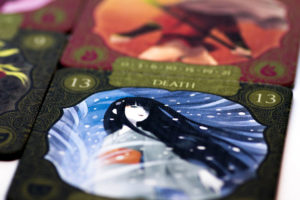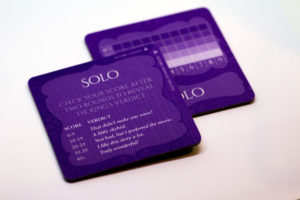 Board gaming for me is often a competitive outlet. It allows me to compete against (or with) friends and strangers alike. I enjoy the deeper strategy games where the choices you make really have a big impact on the outcome. But sometimes by the time it’s all said and done you can end up frustrated and have a brain-burning headache.
Board gaming for me is often a competitive outlet. It allows me to compete against (or with) friends and strangers alike. I enjoy the deeper strategy games where the choices you make really have a big impact on the outcome. But sometimes by the time it’s all said and done you can end up frustrated and have a brain-burning headache.
Shahrazad certainly won’t give you that feeling. It is a simple tile-laying game where players place gorgeous tiles to form a story for the king. It may not have the hardest decisions in the world to make, but is it fun to play?
Shahrazad is a tile laying game for 1-2 players that takes about 15 minutes to play. Shahrazad plays best as a solo game.
Game Overview:
In Shahrazad, one or two players cooperatively attempt to place story tiles to make the most successful story to impress the king. To make a great story, the tiles must ascend from left to right and attempt to group colors together as much as possible.
After all tiles are played through two rounds, players take their total score and get a brief review from the king.
Game Components:

Shahrazad comes packed in a small box with 24 tiles and the rulebook. Twenty-two of the tiles are the story tiles used throughout the game. The other tiles are scoring tiles — one side for solo scoring and the flip side is used for a two player game. The tiles are very sturdy cardboard tiles that really feel great to play with, although are somewhat awkward to shuffle.
The art, from Kotori Neiko, on the story tiles is the real standout of Shahrazad. Each tile depicts a unique scene from a fairy tale. The illustrated style really makes Shahrazad feel like you are laying out a children’s book.
How To Play:
A game of Shahrazad is played over two similar rounds, with scoring in between. In the first round, you randomly choose one of the story tiles to be the start of your story. From there, you must place tiles touching at least one existing tile and attempt to lay out the story in a way that tiles that are touching ascend in value from left to right.

The rules for solo play and two player are almost identical. You have two tiles available to you, and can will place one tile on your turn before drawing a new tile. In a two player game you will alternate tile placements.
Instead of placing a tile, you may also replace an existing tile in the story with one from your hand. You will still draw a new tile, briefly having three in your hand. On your next turn you must place two tiles before drawing a new tile again.
Once all tiles are placed, you verify that there are no tiles that have a higher value touching them on the right. All tiles must have a path from the far left to the far right column. Any invalid tiles are removed and placed back in the box. You then score points for the largest grouping of each of the two colors.
After scoring the first round, you choose one column to keep as your starting column for the second round. All other remaining tiles get shuffled up and you repeat the process of the first round. You add your scores from the rounds together for your final score and consult the scoring tiles to see what the king thought of your story.

Game Experience:
Shahrazad seems to be more of a puzzle than a game. The mechanisms are simple and, for the most part, each individual choice is relatively straightforward. I enjoy it mostly as a solo game. Shahrazad provides a reasonable use for 10 minutes of your time if you are looking for something to pass the time.
I haven’t done a lot of solo gaming, and I don’t consider myself a solo gamer. I wouldn’t consider pulling Terraforming Mars off the shelf and taking 90 minutes to play through it by myself. But a much shorter experience is something I might just keep around when I’m impatiently waiting on game night to start or something. It provides a bit of a calming experience just placing tiles and enjoying the artwork without needing any real setup or brain burning decisions.
As a two player game, Shahrazad loses some of the calm, relaxing atmosphere. For starters, I’m never a fan of games where there is some ambiguity over what you can tell someone on your team. You aren’t supposed to tell them exactly what tiles you are holding, but you can discuss where they can or can’t place tiles for this turn. I had an OK time playing this with my 10-year old when it was more about the experience. Plays with people with a more gamer mindset didn’t go over very well as there was a bit more frustration over the tile placement.

The last couple of tiles can also play out a little strange. I’ve found myself often just having tiles left that I don’t have a place for and I’ll throw them at the very end knowing they will just not score. This means there isn’t a lot of tension normally about what is coming or hoping you “get there.” Each tile does have a reminder of what value tiles exist for that color, so it is certainly possible I’m just playing sub optimally.
I’m also concerned that, being more of a puzzle than a game, it’s possible to solve Shahrazad. There is definitely a single layout for the 22 tiles that will score you 22 points. I’m sure knowing that layout and committing it to memory isn’t something most people will do. However, I certainly have a few analysis paralysis prone gamers in my group who I could see agonizing over the options and really overthinking what is an otherwise enjoyable short experience. I would prefer some random element where the exact tiles that are in the game aren’t known to add a little bit more variance to each game and reduce the issue of solving the game.
Final Thoughts:
If you feel like there is utility for you having a game you can play by yourself in 10-15 minutes, I’m more than happy to recommend Shahrazad. I think it shines as a replacement for passing your time on some random mobile app.
I also enjoyed playing with my 10-year old and I think those gamers wanting to play with kids will like this. The artwork really draws you into what is otherwise a themeless puzzle of putting numbers in a row and seem to really connect for my daughter.
If you are looking for a challenge, Shahrazad isn’t it. It is extremely simple in both rules and execution. There are only a couple of decisions to make. You aren’t going to feel like you made any clever decisions, but you may just pass enough time for the rest of your game group to arrive.
If you’d like to get a copy of Shahrazad, you can pick it up for about $15.
Final Score: 3 Stars – Good for a quick play when you want to pass the time, but isn’t going to offer you a significant challenge.
 Hits:
Hits:
• Great artwork and production quality
• Calming and short solo experience
• Inexpensive
Misses:
• Two player version can be a bit frustrating
• Lacks tension and has a “solution”






















